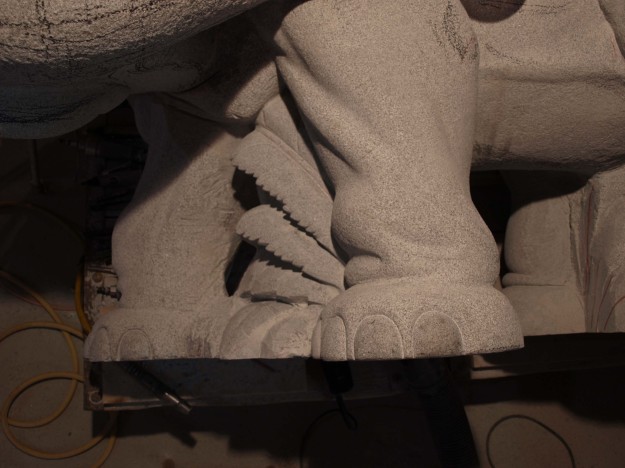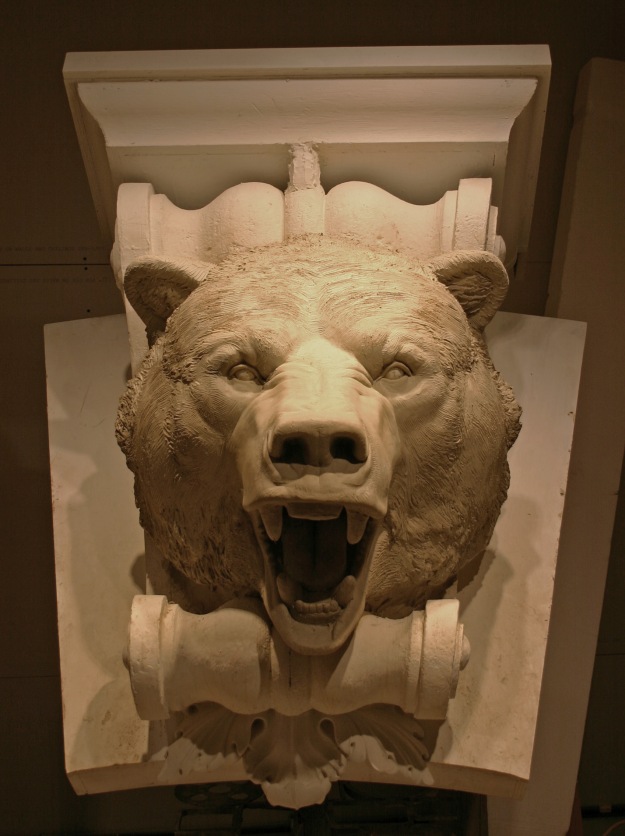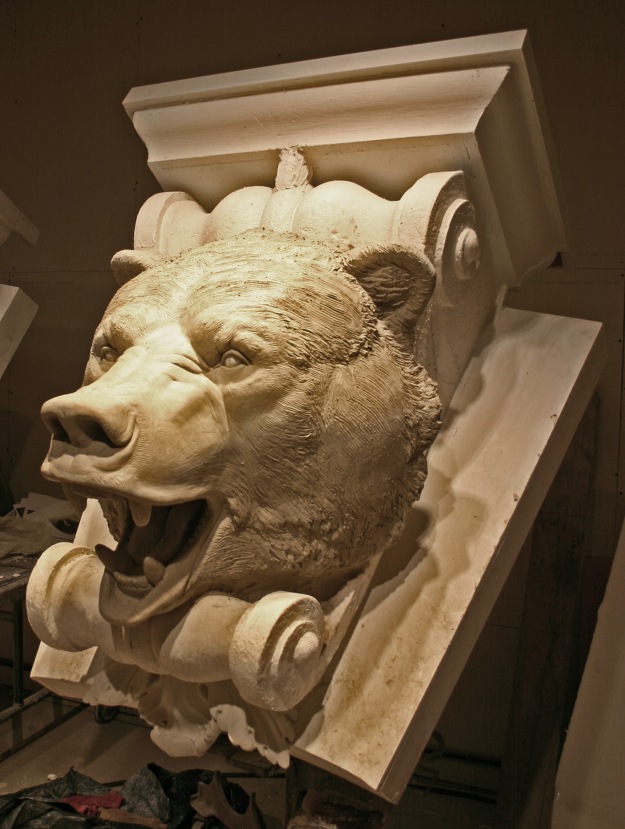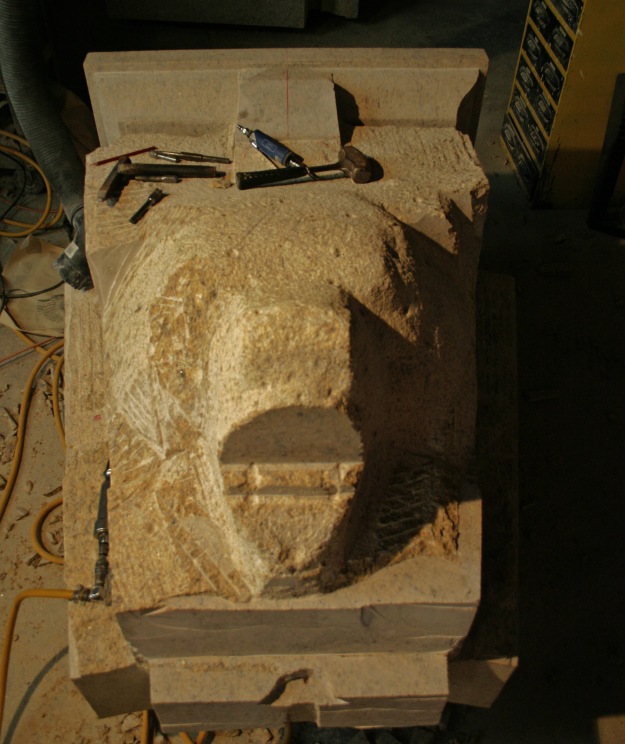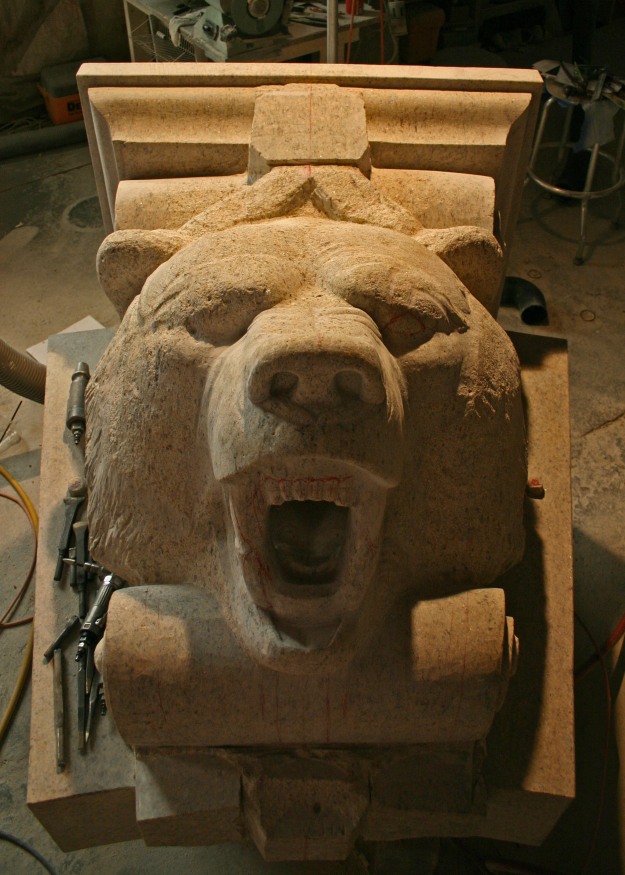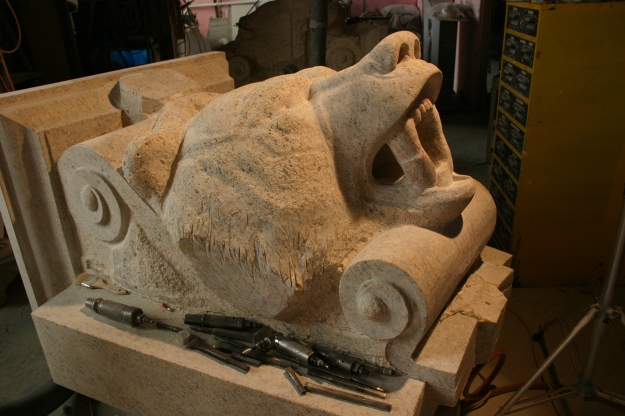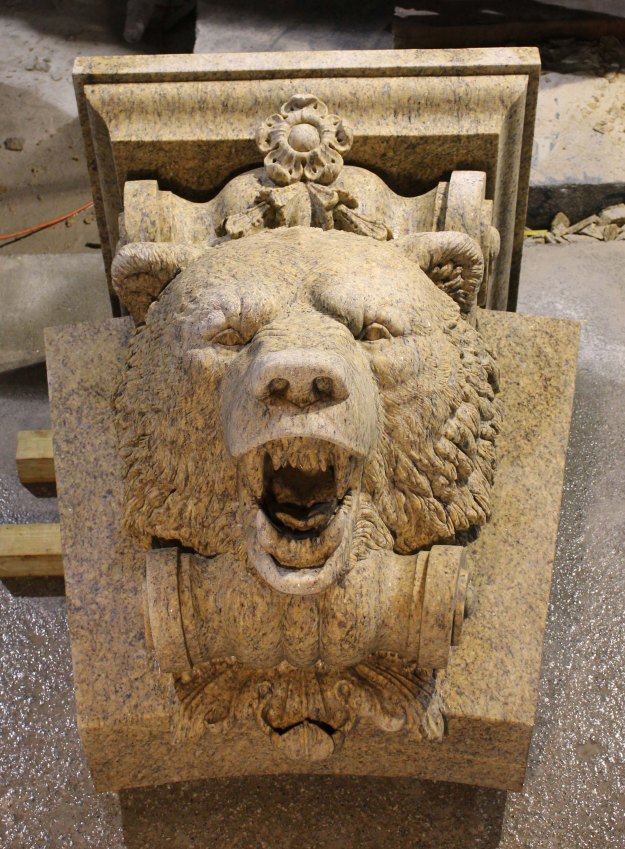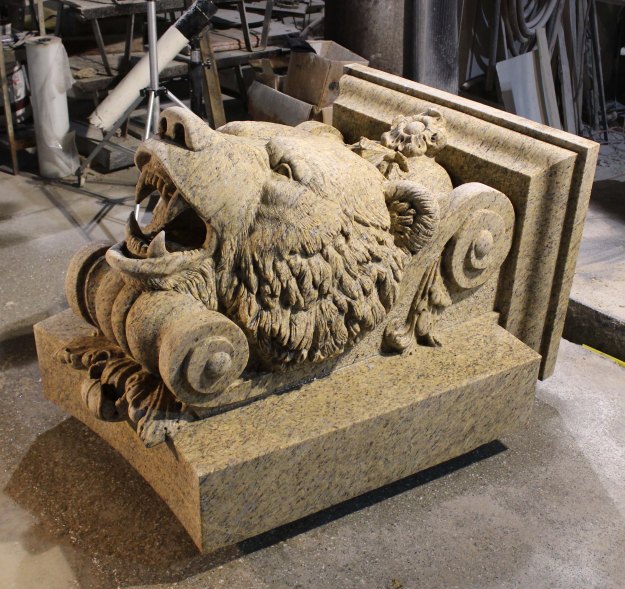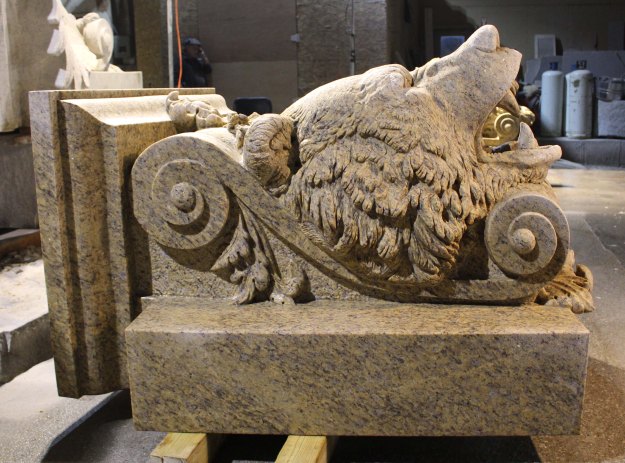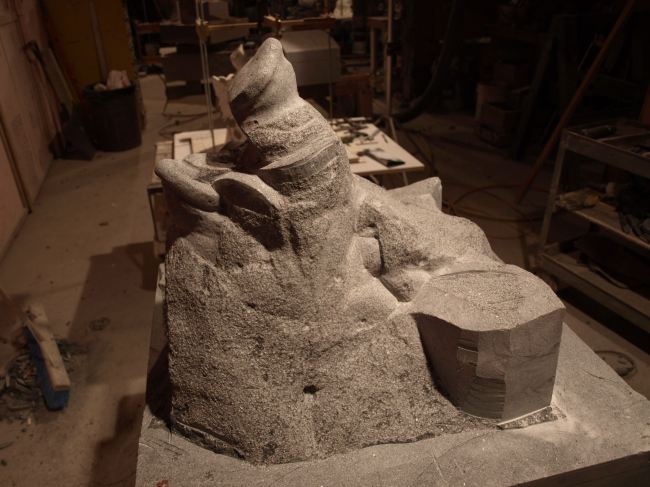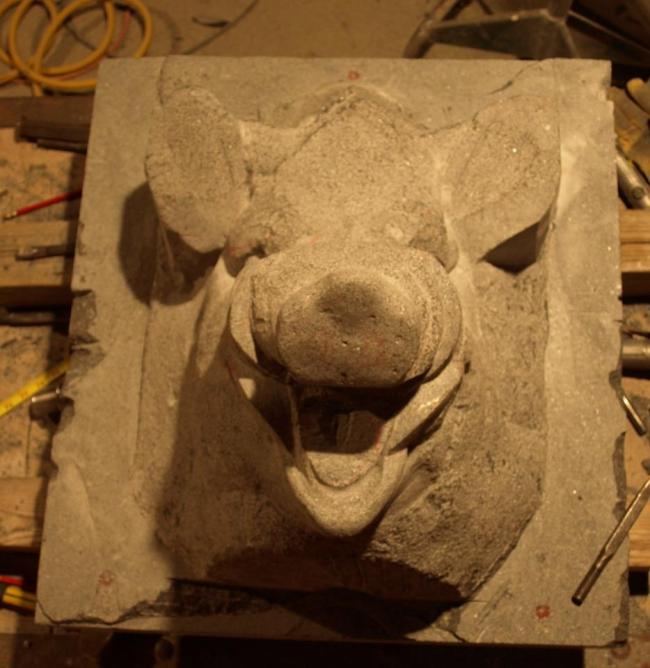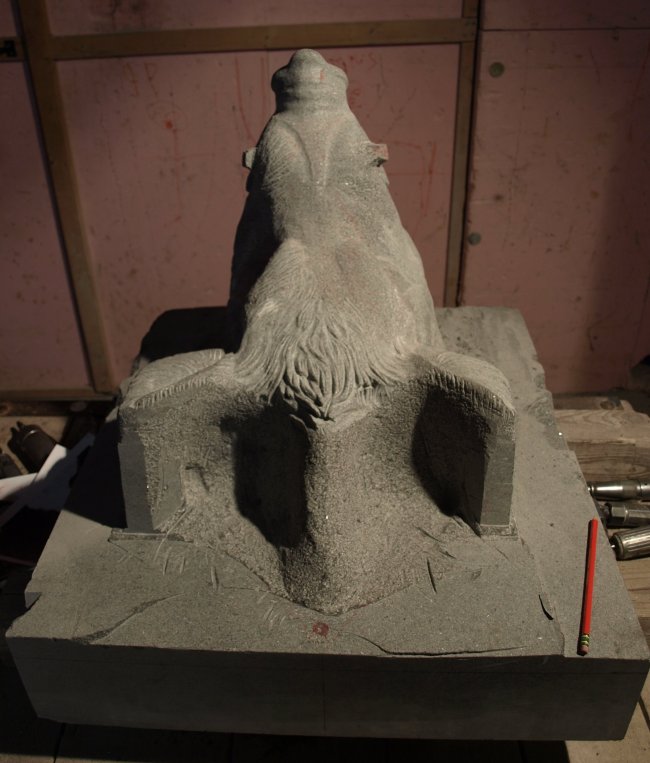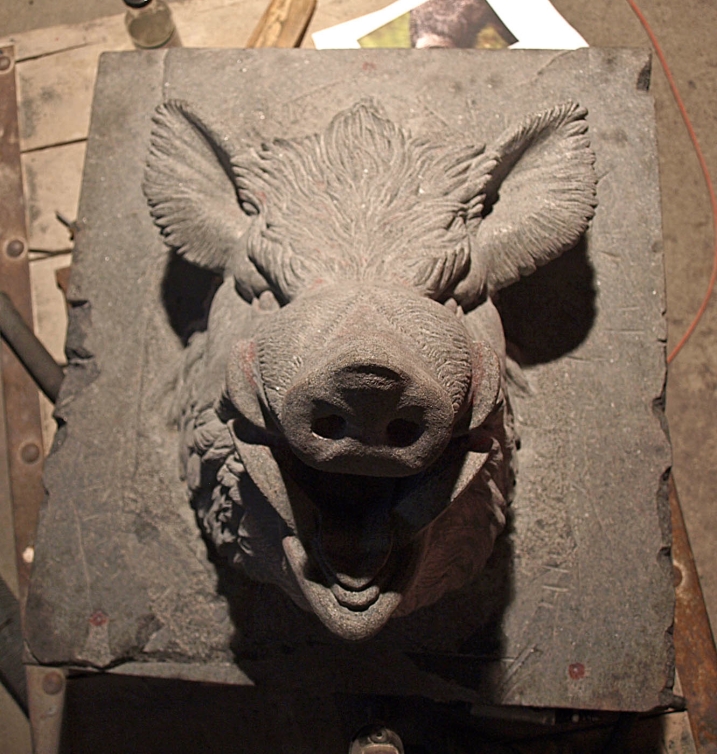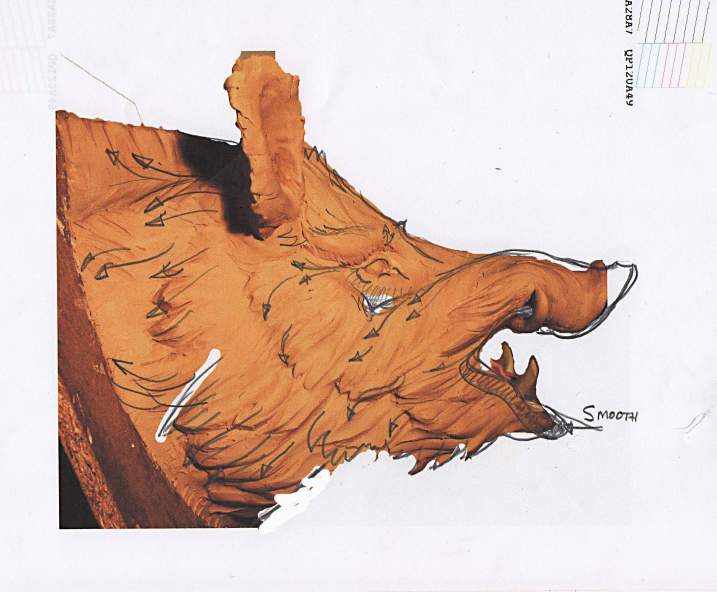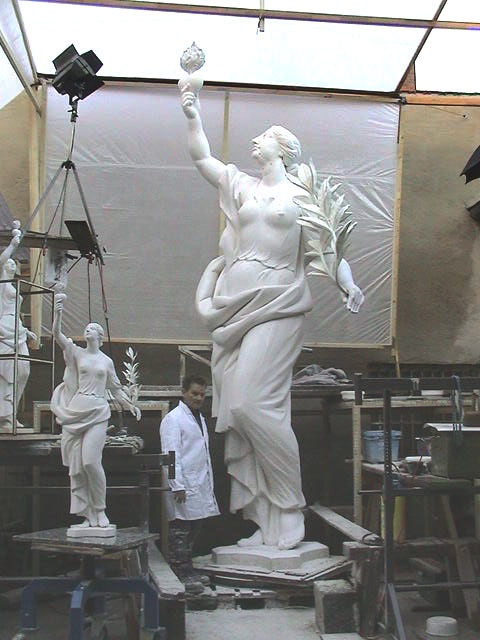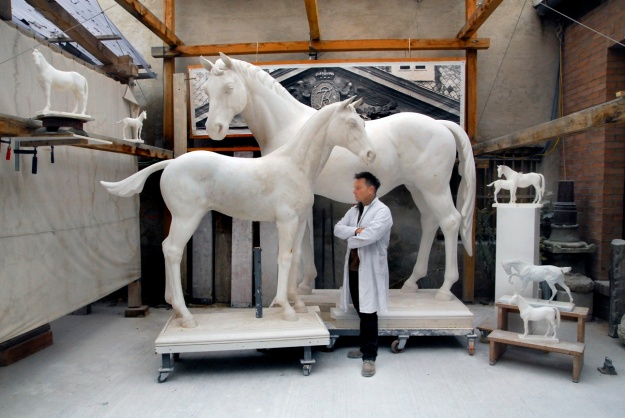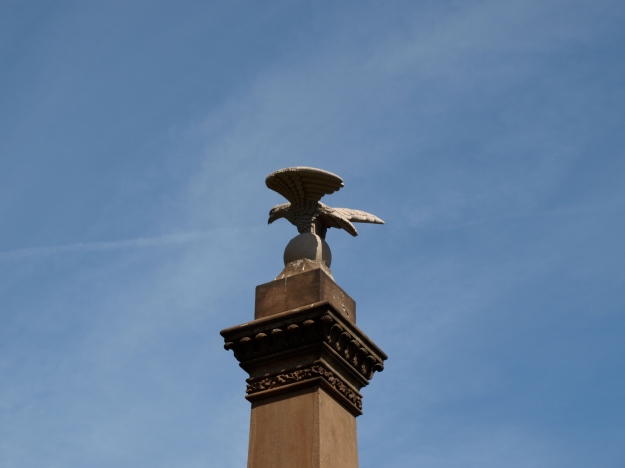For the better part of 2014, I was working on a larger than life sized grizzly bear head, mounted on an architectural keystone. The keystone had scroll elements, known as a corbell, and acanthus leaves on the sides and under the bear’s jaw. Above the bear head is a rosette, with some basic wreath work that blends into the hair, and ogee moulding overhanging the front of the face and going back into the wall. I’ve included some progress photos showing the carving in its unfinished form, and the preliminary model in clay. Done for Barre Sculpture Studios as one of three keystones. The measurements are approximately 4 x 4 x 3ft.
Tag Archives: Stone Carving
Carving the Boar
Over the last 4 months, I have been used the boar head model I sculpted in Berlin to carve the final version in stone. Here are the pictures from that process. Since the early stages aren’t really that interesting to look at, I will start with what the carving looked like about 6 weeks into the carving. Bear in mind I started from a solid block.
The last photos are after around 3 months of work. We are still waiting on a final template for the background and in the end the background will be pitched stone and in some kind of an oval shape.
Something Wild
Hey Ya’ll,
been a while since I posted anything. So here goes!
In addition to all the comedy I’ve been doing at night, I have have also been working on a commission for Barre Sculpture Studios back in Vermont. The project is a wild boar, to be carved in granite this winter. Here are some progress shots so you can see the evolution of the piece.
- (C) Barre Sculpture Studios
To get a better idea of hair direction, here is a drawing that was done over the photo for some final editing before the sculpture is cast.
Practice piece/ Übungsstück
I’m far from Granite country, ladies and gents. Out here in Germany, they most carve sandstone. There may be work for me in the future, but first I have to show that I can also carve sandstone like they do in the old country.
This piece is being done entirely by hand (no pneumatics or angle grinders) and without pointing. It’s not exact, it’s not as accurate as I’d like it to be, but it’s been a great learning experience. Sandstone is a delight to carve, and is very much like modeling in clay, as opposed to the uphill battle that is granite carving.
The stone I chose wasn’t big enough to fit the entire body of the dophin, and I didn’t want to do the extra work of measuring to make a half size version so I could fit the entire body into the stone. In hindsight, that may have been easier and more beneficial… the version I am making now is the dolphin coming out of the water, without the fin on his back.
Hopefully I get this done before I bounce to Thailand for the winter!
It’s getting dark much earlier these days, and by the time I want to take some photos at the end of the day it’s dark already. The hold doesn’t help me hold the camera steady, either… here is the practice piece with the model I am loosely working from. It’s a kind of baroque dolphin that you would see in Italy — in fountains, door handles, belt buckles, etc. Not much like a dolphin at all, aber ist einfach so.
This is still very rough. Lot of work to go, but I love how fast things can go once you know what you want. I am not really at a point where I can fluently make observations and then go to the right chisel to get what I want. It’s trial and error until the owner of the shop comes by and say, “What the hell are you doing? You do it like this…”
The chisels that one uses for sandstone are very different from the chisels for granite. They are all very thin and sharp, and you never pound the stone directly. It’s more like modeling with a rake tool in clay. You might notice that some of the surfaces are pretty smooth. That’s because I have no idea what I am doing and I wanted to try out the flat chisels. I know now that the entire sculpture should be covered in rake marks (the striped pattern on the back created by a 4 toothed chisel) until the very end.
After showing the pictures to Jerry from Barre he reacted with a similar, “what the hell are you doing?” but after the initial wave of criticism he softened up and said I should make the scales rounder, and pop in the eye so I know what I’m doing. So here’s where I’m at now.
Of course, Jerry was right. The rest of the piece seems to make more sense now. Next on the list is the lips and teeth, the I will probably finish up with smoothing out the back and doing the rest of the scales.
So this is the start of my first piece in sandstone. I have really enjoyed it, and learning about new tools and techniques. More to come later on!
Steinrestaurierung Hoferick: Deutsch Amerikanische Freundschaft
Dialog der Kulturen
Ein Amerikanischer Steinbildhauer interviewt einen Deutschen Steinbildhauer.
SW: Sean Williams
Wie bist Du zu deinem Beruf Steinbildhauer gekommen?
A: Andreas Hoferick
Mein Vater geriet im Kalten Krieg zwischen die Fronten und wurde 1972 beruflich passiviert. Daraus erwuchs in mir der Wunsch beruflich etwas ganz Anderes zu werden und die musischen Ambitionen meiner Mutter führten mich zur Bildenden Kunst. Die lange unfreiwillige Kindheit in der DDR und sozialistische Erziehung gegen die ich mich früh genug positioniert habe und deshalb nicht an den DDR-Kunsthochschulen studieren durfte, führte zu einem ausgeprägten alternativem Denken. Deshalb auch der Umweg über eine Bergbaulehre im Kupferschieferbergbau (Lehrling im Bergbau) . Danach begegnete ich auf meiner Suche nach einer Bildhauerwerkstatt dem Steinbildhauermeister J. Klimes in Berlin. Er war Leiter einer Klassischen Bildhauerwerkstatt mit 27 Kollegen und vermittelte historisches Handwerk in der Steinbildhauerei. Kulturell und alternativ orientierte Menschen hatten in der DDR lediglich in einer Nische eine Überlebenschance. Und für mich bot sich diese Gelegenheit in der Werkstatt Klimes. Isoliert von der Welt, konnte ich mich in 11 Jahren Anstellung den Klassischen Stein-Skulpturen widmen, die es zu rekonstruieren galt, denn durch den II.WK waren in Berlin hohe Verluste entstanden.
SW: Wie und wann ist Deine Werkstatt gegründet worden?
A: Als die Werkstett Klimes 5 Jahre nach der „Maueröffnung“ in dem Neuen Wirtschaftssystem nicht mehr überlebensfähig war entschloss ich mich 1995 mit 3 weiteren Kollegen eine kleinere Werkstatt auszugründen und ich fand Anschluss an des Kollegium der Restauratoren Berlin welches eine freie Assoziation von Restauratoren im selben Stadtbezirk Weißensee war und ist. Von 1989-1993 studierte ich an der TFH – Wedding Steinrestaurierung, so kann ich meine Steinbildhauerischen Arbeiten unterstützen.
15 Jahre lang (1995-2010) ist es mir gelungen die Werkstatt Hoferick in demselben Stil wie die Werkstatt Klimes weiterzuführen, allerdings nur noch mit 7 Mitarbeitern.
SW: Welches war das Projekt mit der interessantesten Herausforderung für Dich und warum?
A: Pferdeportraits sind noch vor den Kolossalskulpturen wie z.B. der der „Caritas“ welche eine Größe von 5,70 m besitzt, eine besondere Herausforderung. Abgesehen von meiner unbefangenen Entdeckung, dass Pferde Fabelwesen gleichen, ist die Skulptur eines Pferdes wohl das Komplizierteste was einem naturalistisch arbeitenden Bildhauer begegnen kann.
SW: Wie ist Deine Werkstattphilosophie?
A: Skulpturen oder Ensembles zu schaffen, die der vermeintlichen Kurzlebigkeit unserer Zeit widerstehen. Wir kreieren die historische Zukunft in unserem Metier: Steinbildhauerei
SW: Wie sieht die Zukunft für Dich aus?
A: Was ich als nächstes machen will ist meine KUNST in anderen Ländern und Kulturen bekanntzumachen und an den in der Kunst bisher üblichen Selbstdarstellungen vorbei zu agieren. Z.B Themen anderer Kulturen aufzunehmen und in einem kulturellen Dialog bildnerisch darzustellen.
English:
SW: How did you become a Stone carver?
A: Andreas Hoferick
In the cold war my father operated between the two fronts and was occupationally passified in 1972. From then on there grew a desire to become something completely different and my mother’s musical ambitions drove me to fine art. The long restricted childhood in the DDR and socialistic upbringing, which I had been against early on and thus didn’t allow me to study in the DDR fine art colleges, lead me to an distinct alternative route. I began with the indirect route of becoming and apprentice in a copper mine. Afterwards during my search for a scupture workshop I came across the Stonecarver J. Klimes in Berlin. He was the head of a classical sculpture workshop with 27 co-workers and subcontracted historical works of sculpture. Cultured and alternatively oriented people in the DDR’s only chance to survive was finding a Niche. The workshop of J. Klimes offered me this opportunity. Isolated from the world, I was able to dedicate 11 years of employment to classical stone sculpture intended for reconstruction, and the many losses of WW2 in Berlin provided ample work.
SW: How and when did you establish your workshop?
A: When Klimes’ workshop was no longer viable in the new economic system 5 years after the ‚opening of the wall’, 3 other colleagues and I resolved to start up a small workshop and found connections in the College of Restuaration Berlin which is a free association of conservators in Weißensee. From 1989 to 1993 I studied stone conservation at the TFH-Wedding (University of Applied Sciences), which supports my work as a stone carver. For 15 years I successfully ran the workshop Hoferick in the same fashion as the workshop Klimes, if only with 7 co-workers.
SW: Which was the project with the most interesting challenge for you, and why?
A: Horse portraits, even in comparison to collossal sculptures like „Caritas“ which is 5.7m tall, are especially challenging. Irrespective of my naive observations, the horse is that of a myth, and the form of a horse if definitely the most complicated form that a figurative sculptor can come up against.
SW: What is your workshop Philosophie?
A: To create sculptures or compositions, that withstand the professed humanity of our time. We create the historical future in our profession: Stonecarving.
SW: What do you have in mind fort he future?
A: What I want to do next is to make my art well known in other countries and cultures, and to work past what has been traditionally called self-expression in art. For example: taking up themes of other cultures and expressing them in a visual cultural dialogue. Stone carving is an age-old tradition in which every person doesn’t have to think of within a specific epoch or culture and in times of such global thinking it is important to foster a continuation of these skills.
Fotos mit freunchliche Genehmigung von Andreas Hoferick
Photo provided courtesy of Andreas Hoferick
Rubber Chicken
The newest work to come out of Barre Sculpture Studios. That’s right, a granite rubber chicken. A gem that lasts a lifetime.
Studio Place Arts in Barre, Vermont
I completely forgot to do a post on this!
The two stone pieces that I did this past summer are up right now at SPA in Barre, Vermont.
http://www.studioplacearts.com/
Go see Barre’s finest while you still can. Exhibition comes down at the end of October.
Stone Works am Ende
After three months back home in Vermont, I am back in Berlin. I’ll be picking up where I left off, doing more with Johnen Gallerie and assisting artist Olaf Holzapfel.
Here are the final photos of my two stone sculptures I did while at home. Remember folks, this was just practice.
Also, I worked on the Julius Caesar profile portrait a little more. Here is the final photos of that piece. Thanks to my friends at the online Sculpture Community , I found out who sculpted the original. The cast was of a carving done in 15th century Florence, by Desiderio da Settignano. The depiction is of Julius Caesar, and was sculpted in 1460.
So! Those were my two first carvings that I did this past summer. More to come, in the coming years. For now, back to drawing and pastel.. Thanks so much to Jerry for taking the photos and editing them after I left home–again.
Voltaire Continued
Once you’ve done all the roughing out with black granite, then you really start to appreciate the detail that you can get with this stone. The grain is really fine, and the dense stone is really strong, allowing you to use smaller and smaller chisels for fine detail. I have just started to punch in the eyes, and will be finishing those up, and trying to get the finer wrinkles around the eyes and mouth.
As you can see, I am working from photos at this point and trying to take my sculpture farther than the cast that I used to rough the face out. There are multiple versions of Voltaire done by Houdon, depicting him bald, and with a headband and wig. I am doing the version with the headband, but trying to go after the detail of the marble carving.
At this point, drawing on the stone is important, and more enjoyable than it is during the earlier phases. Through constant drawing and re-drawing, you eventually achieve the level of detail desired. I’ve added 4 new chisels to the mix, and may invent a few of my own as I progress.
Voltaire Case Study
In this post I will show you the phases of a pointed stone carving start to finish. Of course, I’m not showing all the tools I am using at each phase, but some things are just tricks of the trade and will remain a mystery… unless you want to come to Vermont and see for yourself!
The photo shows the initial cuts in the stone, and the first few points made from the original.
Here, I’ve cleared away a lot of the stone between points and started to go after some of the details.
At this point, I would say the piece is “roughed out”, and I am ready to start going after the details.
After roughing the piece out, I begin to become more systematic and go after sections of the face. I’ve started with the mouth, and I will move my way up the face, and then begin to push farther back to get some of the jaw line and the ears. For the finished piece, I would like to create an effect that the face has emerged out of a rough piece of stone, and leave marks from each phase.
True Blood
After a few grueling weeks hunched over this granite block, I’ve come out with something that I would call finished. We’re still not sure who from history is depicted here, so if anything screams out at you let me know.
For my next sculpture, I will be doing a full size portrait of Voltaire. Through reliable sources I obtained a copy of the original sculpture done by Jean-Antoine Houdon, which sits in Montpellier, France.
This week thing got off to a rough start. Unlike Houdon, my sculpture will be carved out of South African black granite, which I like to call, Unabtainium (it was a toss up between Unabtainium and Kryptonite, you decide which is funnier). South African black has turned out to be not only extremely hard, requiring me to swing the hammer a little harder each time I need to break something off, but as sharp as broken glass when it splits. Oh, I’ve had my fair share of missed swings, but this week was brutal. This may not look like much, but bare in mind this is after 3 missed swings at full speed with a 8lb sledge.
It’s puffier than a muffin top.
5 minutes of grunting, stamping, and teeth grinding later, I found out just how sharp this stone is.
Being something of a fatalist, I decided that life was trying to tell me something. Just moments before this photo was taken there was literally blood pouring down my face. Kind of like that scene from The Fifth Element when Zorg is talking to the darkness… The piece of stone hit me directly in the middle of my forehead, right in my third eye. I immediately looked up what a bindi represents on wikipedia. Apparently, the bindi represents concealed wisdom, and strengthens concentration. The bindi is placed on the site of the sixth Chakra called, Ajna.
It was like an ironic epiphany to start bleeding out of my mind’s eye and I do feel a bit wiser and definitely more focused…
Profile/Recent Work
For my first piece this summer I will copy a roman relief carving of… a senator. If you can tell who it it from the picture please let me know. We have the plaster cast in the shop and I figured it would be good practice to get started. I’ve been doing all the with with a pointing machine and things are going pretty smoothly.
Eagle Installation
So I’ve been back in Vermont for about 3 weeks now. Since I’ve been back I went down to East Hartford, Connecticut with Jerry for an installation of one of his most recently finished pieces. The eagle monument was a historical restoration job. The original was carved out of brownstone just after the civil war.
Job well done!
Angel Carving
Here is a gravestone I’ve been doing. Here’s the model. Original artwork done by Jerry (I’m just the muscle).

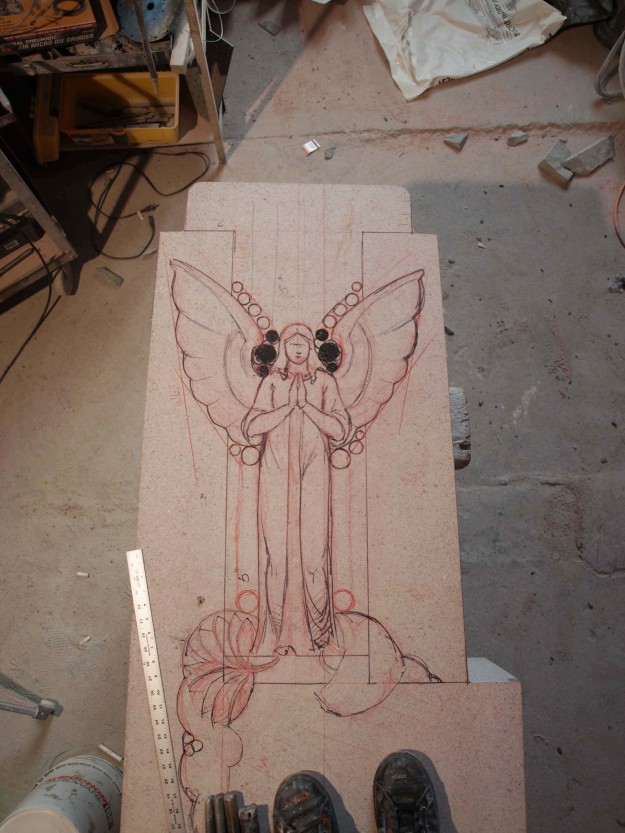
First the a drawing on the stone to mark the outline of the relief.

Then holes are drilled around the drawing, and the stone surrounding the drawing is knocked back.

Cuts are made to remove the stone easier. Larger saws require water.

The right side is what it looks like after the cuts are knocked back. The left side is planed down with a diamond saw, now chiseling has to be done to push the stone back another 1/4 in. , removing pockmarks and creating a level surface.

This is how far I’ve gotten to date. It may not look like much, but to create a level surface without chipping the edges or going too deep is pretty hard. You can’t actually use an angle grinder until everything has been brought down with a couple different chisels.
This is also a good example of how apprentices start learning to carve. The area around the stone left for the carving is called a niche. A lot of niches are circular or oval. I would say those are a bit easier, but it is tricky to make a nice edge on those too. What’s nice is that once this is out of the way I can go back to carving sculpture. I definitely have a greater appreciation for clay now.
The crazy thing that I never really think about is… this is someones gravestone.
R.I.P.
Elephant Detail
With one statue out the door, there is more space for new work. The second elephant is being set up while the first one is nearing completion, and there is a gravestone which I started on Monday (11/9/09).
Here is the elephant in its new position. I’ve been working on the legs and the leaf detail that surrounds them. First off, we laid the elephant on its side.


